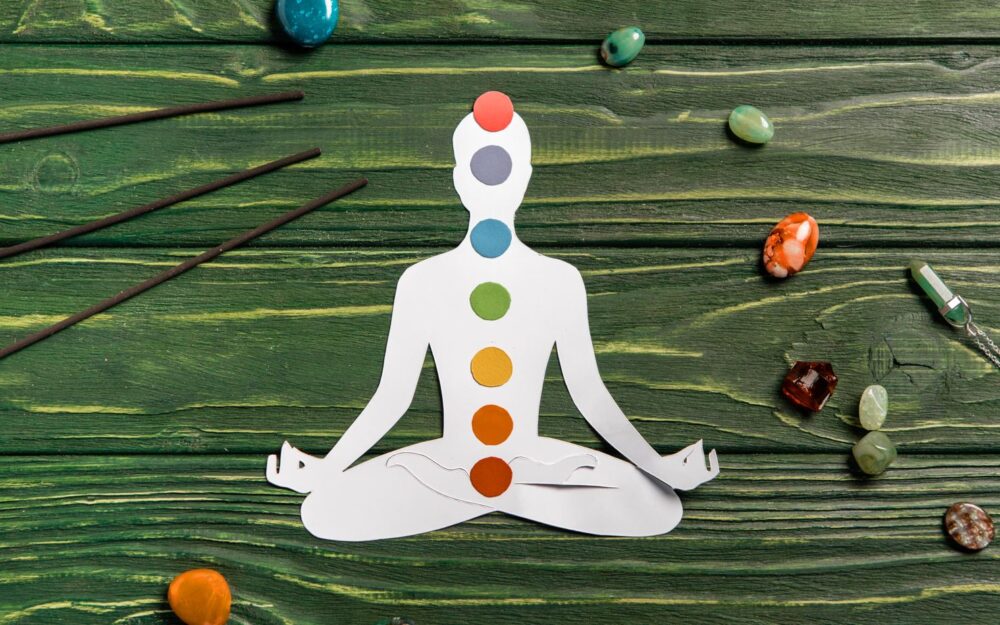For thousands of years, Hindu, Buddhist, and yogic spiritual traditions have emphasized chakras, which are crucial to meditation. This powerful practice uses chakras to enhance consciousness, energy balance, and well-being. How?
Well, for starters, chakra meditation improves life balance and harmony. Each chakra affects our physical health, emotions, and spirituality in a different way. When we meditate focusing on these chakras, we can figure out energy imbalances and restore equilibrium. For example, to calm our nerves and boost our confidence, we can focus on the solar plexus chakra.
Chakra meditation balances energy and helps us connect with ourselves. Focusing on each chakra and its emotions helps us understand our ideas, feelings, and experiences. Self-awareness can help us identify the reasons of physical or mental disorders and provide a path to resolution. For instance, we might focus on the root chakra to understand the emotional or mental obstacles causing physical suffering.
But the perks don’t stop here, as the practice also has a deep spiritual link. To-do lists help us to keep track of what we need to do, when we need to do it, and how much time we have to complete each task. Even in terrible times, this can help us discover meaning and purpose.
Now the only question left is…

How do chakras work?
Human chakras are energy centers that affect our health. Each chakra is connected to specific parts of our lives and forms a comprehensive system. Many Eastern spiritual traditions emphasize chakra awareness and holistic health.
In these traditions, the body has a complex network of energy conduits, called nadis, that transmit life force energy, or prana, throughout. Thoughts, emotions, physical activity, and the environment can affect the chakras, which allow energy to move in and out of the body.
Balanced chakras allow life force energy to flow freely, promoting physical, emotional, and spiritual well-being. Conversely, blocked or imbalanced chakras can cause physical, emotional, or mental health concerns.
Meditation helps balance chakras. We can find energy blockages in the chakras and relieve them to allow life force energy to circulate freely throughout the body. Meditation with visualization and affirmations helps balance and align chakras, improving health and well-being.
Which are the seven chakras?
The seven chakras are thought to affect our physical, emotional, and spiritual health. From the base of the spine to the summit of the skull, these chakras affect our physical health, emotions, and spirituality.
The root chakra, located at the base of the spine, represents our connection to the earth and nature. Red symbolizes safety, stability, and grounding for this chakra. Balanced root chakras give us faith and strength to meet our basic human needs. When this chakra is imbalanced, you’ll probably feel anxious and just have an overall bad mood.
The crown chakra, at the top of the head, connects us to the divine and spiritual enlightenment. This violet-colored chakra is related with spiritual fulfillment, inner calm, and enlightenment. When the crown chakra is balanced, we feel connected to the divine and at peace. It can cause spiritual bewilderment, alienation, and a lack of purpose when imbalanced.
The sacral chakra, in the lower belly, controls sexuality, creativity, and emotions. Passion, sexuality, and creativity are related with this orange chakra. Balanced sacral chakras provide us confidence and joy in relationships and creativity. When imbalanced, we may feel guilt, humiliation, or insecurity.
The solar plexus chakra, is positioned in the upper belly and governs our power, self-esteem, and identity. Confidence, self-esteem, and self-worth are related with this yellow chakra. Balanced solar plexus chakras help us to achieve goals. Anxiety, worry, and low self-esteem can result from imbalance.
Love, compassion, and relationships are associated with the heart chakra, at the center of the chest. Green symbolizes love, compassion, and connection in this chakra. Balanced heart chakras provide us a deep connection to others and compassion for the needy. Jealousy, rage, and resentment may result from imbalance.
Communication, self-expression, and creativity are linked to the throat chakra, the fifth chakra. This blue chakra represents self-expression, creativity, and personal power. When the throat chakra is balanced, we may speak and create with confidence. Its imbalance can cause fear, timidity, and insecurity.
The sixth chakra, the third eye chakra, is placed between the eyebrows and represents intuition, knowledge, and spirituality. Indigo represents intuition, spirituality, and inner insight. Balanced third eye chakras provide us a strong connection to ourselves and the world. Its imbalance can cause confusion, anxiety, and disorientation.
Meditation is considered to improve physical, emotional, and spiritual well-being by balancing the chakras. Visualization, affirmations, and focused breathing can balance chakras. The practitioner visualizes a spinning wheel of light or color for each chakra and balances it. Focused breathing and affirmations can increase awareness of body sensations and relax the mind.
Meditation and chakra balancing can help us connect to ourselves and the world, fostering personal growth and transformation. We may improve our physical, emotional, and spiritual health and feeling of purpose by balancing and harmonizing our chakras.
Overall, the seven chakras affect our bodily, emotional, and spiritual wellness. Meditation can unlock our inner wisdom and improve our lives by balancing the chakras. Exploring the chakras can be a rewarding and life-changing experience for beginners and expert meditators alike.

Meditation on Chakras
Meditation balances and harmonizes the chakras. Each chakra meditation practice has its own merits. Common chakra meditation practices include:
Visualizing each chakra as a spinning energy wheel and focusing on each one is chakra visualization. Visualize the chakra spinning freely and use affirmations or visualization to balance and align it.
Chakra affirmations: Focus on a chakra and repeat affirmations relating to it. “I am open to love and compassion” or “I am worthy of love and acceptance” are good heart chakra affirmations.
Chakra breathing: Focus on each chakra and take deep breaths, envisioning the breath flowing into it and balancing it. As you breathe, imagine the chakra spinning freely.
Sound meditation balances chakras. Singing or chanting chakra-related sounds or words or listening to chakra meditation music can do this.
Chakra meditation requires an open and relaxed mind, regardless of technique. Sit or lie down for some quiet time. To relax, support your body with cushions or blankets and focus on your breath. While meditating, you have to literally visualize the first chakra rotating freely. Spend several minutes on each of the seven chakras. You can also focus on one chakra per day or on a chakra you think is out of balance.
Remember, chakra meditation is about awareness and letting the chakras balance themselves. As the chakras balance and align, your physical, emotional, and spiritual well-being will certainly improve with consistent practice.
Conclusion
The seven chakras, energy wheels in the body, represent our bodily, emotional, and spiritual selves. Root, sacral, solar plexus, heart, throat, third eye, and crown chakras.
Chakra meditation balances these energy wheels in the body, resulting in physical, emotional, and spiritual benefits. Chakra meditation can relieve stress, anxiety, emotional balance, self-awareness, physical health, and spiritual growth and connection.
Meditation on the chakras improves physical, emotional, and spiritual health. Your journey has just begun. Encourage yourself to study and practice chakra meditation. As you learn and explore, you’ll see how these spinning energy wheels in your body can help you achieve balance and harmony.
Read also: The Unexpected Life Lessons You Can Learn From Meditation









